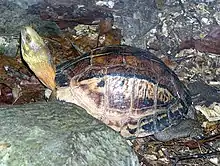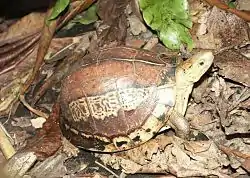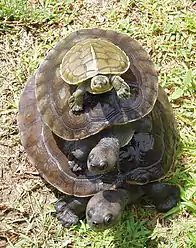Southern Vietnamese box turtle
The southern Vietnamese box turtle (Cuora picturata) is endemic to the southern mountainous regions of Vietnam, and possibly also occurring in extreme eastern Cambodia and southern Laos. It is known only from Khanh Hoa and southern Phu Yen provinces, but may also occur in eastern Dak Lak and northern Ninh Thuan provinces.
| Southern Vietnamese box turtle | |
|---|---|
 | |
| Southern Vietnamese box turtle Cuora (galbinifrons) picturata | |
| Scientific classification | |
| Kingdom: | Animalia |
| Phylum: | Chordata |
| Class: | Reptilia |
| Order: | Testudines |
| Suborder: | Cryptodira |
| Superfamily: | Testudinoidea |
| Family: | Geoemydidae |
| Genus: | Cuora |
| Species: | C. picturata |
| Binomial name | |
| Cuora picturata Lehr, Fritz & Obst, 1998 | |
| Synonyms | |
| |

This species was initially described as a subspecies of Cuora galbinifrons, but was shown to be genetically distinct.[2] This is the same for Cuora galbinifrons bourreti, which is much closer related to Cuora galbinifrons, though, in osteology, genetics and morphology than is Cuora picturata to either one. Thus, this variety probably truly deserves species status.
This species has the highest-domed carapace of all Cuora species, the shape resembling a conquistador helmet. While the head coloration of Cuora galbinifrons subspecies is highly variable even in different populations, this is not the case with C. picturata, whose head is always yellow with a fine, greyish reticulation.
.jpg.webp)
References
- McCormack, T.; Stuart, B. & Blanck, T. (2016). "Cuora picturata". IUCN Red List of Threatened Species. 2016: e.T163463A115303820. doi:10.2305/IUCN.UK.2016-1.RLTS.T163463A1010522.en.{{cite iucn}}: error: |doi= / |page= mismatch (help)
- Stuart, B. L. & Parham, J. F. (2004). "Molecular phylogeny of the critically endangered Indochinese box turtle (Cuora galbinifrons)". Molecular Phylogenetics and Evolution. 31: 164-177.
- Lehr, E.; Fritz, U. & Obst, F. J. (1998)." Die Unterarten von Cuora galbinifrons Bourret, 1939". Zoologische Abhandlungen aus dem staatlichen Museum für Tierkunde in Dresden. 50: 77-97.

